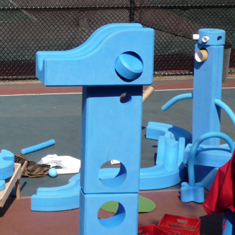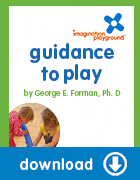Children like to add details to their pretend objects so others will know what the structure represents, adding loops to a flower arrangement or dorsal fins to the back of a dinosaur.

The girls put a crazy looping gizmo on the top of this little room. Not only is this ornament inviting, it also suggests that the theme of play should also be fanciful, like time travel or spinning into space.

Sure, an empty hole could represent the eye, but a slanted Nickel in the hole or cardboard cups make the “eye” symbols much more “readable” by a passerby. These small accents are like adjectives to nouns. They modify the meaning.
What It Means
The accents can serve as a type of signature when the children work to make their conventional enclosure or tower look different or fun. The accents may not have a pretend physical function, like a giant handle on a giant pretend cup would have. But these accents do have a social function (attract others to your worksite) and a communicative function (to make the horse’s eye look like it is winking). When a child adds an accent, she reveals in what way she thought the structure was incomplete.
2-4 Year Olds
At the youngest ages it may not be clear that the accents add to the readability of a symbol. They like to “stick” accessories on because of the visual fun and tension they create, such as sticking a small plug into a large hole just to have something protrude from the wall. But to this youngest child, that accent is essential and completes something the child felt was missing or needed in the structure as a spatial form only.
4-7 Year Olds
For the older children who create large-scale symbols such as furniture, cars, rocket ships—the accents define the function or meaning of component parts, such as a cup on the armrest of a chair or a gear to represent the U.S. emblem on the rocket ship.
7-10 Year Olds
For still older children the accents mark the social function of a subpart of the structure, such as the Queen’s doorway or a motif used to identify a social clique. You will find that the older children will be eager to accessorize a conventional structure. This is somewhat a way of marking their territory, but also a way of adding status to the structure.
This material is adapted from the publication “Imagination Playground’s Guidance to Play” by George E. Forman, PhD, Emeritus Professor, University of Massachusetts (Amherst) and President of Videatives, Inc.
Dr. Forman has over 33 years of experience in university teaching, cognitive research, multimedia design and educational consulting in the area of early childhood learning and development.
“Guidance to Play” covers 20 topics that help illustrate the significance in what children are doing as they play as well as concrete actions Play Associates can take to facilitate positive behaviors.



